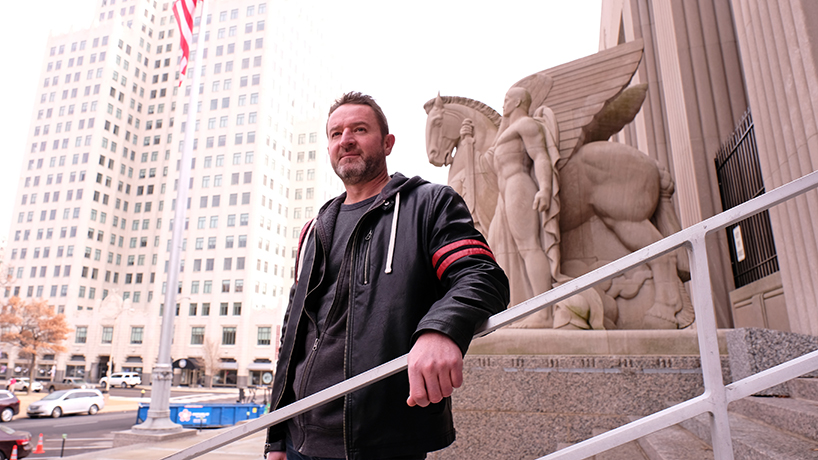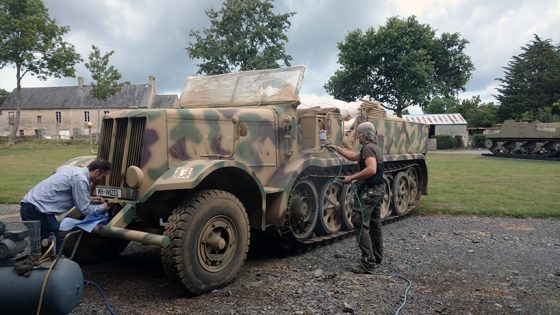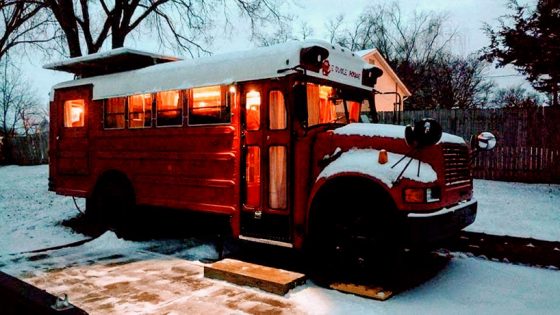
Jeffrey Pryor stands in front of Soldiers Memorial Military Museum in downtown St. Louis. After graduating in December, he hopes to work in France telling the stories of American military buried overseas. (Photo by August Jennewein)
Jeffrey Pryor was in the midst of building an exhibition this summer at the Manhay History 44 Museum when his friend Pierre Veybreyt approached and told Pryor to drop everything. His taxi had arrived.
He hadn’t ordered a car, but Veybreyt kept insisting. Probably a language barrier miscommunication, Pryor thought. The University of Missouri–St. Louis combined BA/MA student was under the impression that his French had become pretty good, but clearly, he needed to keep studying. Finally, he caved and walked out of the institution dedicated to World War II’s Battle of the Bulge in Manhay, Belgium.
Outside sat a genuine WWII U.S. M51 5-ton truck as well as the vehicle’s restorer, the author and historian Eddy Monfort, who wanted Pryor to drive the artifact through the Ardennes Forest to one of the best-preserved sites of the Battle of Bulge.
Strangely enough, this was not Pryor’s first time driving a WWII vehicle. The previous summer, he had driven a Famo, a German half-track, in Normandy, France, when exhibit building at the Overlord Museum.
Pryor, at 44 years old, is on track to graduate in December from UMSL with a graduate degree in history with a concentration in museums, heritage and public history. After a decade in the U.S. Navy Seabees followed by another as a pipefitter at the Department of Veterans Affairs, the Missouri native revolutionized his life. He quit his VA job, sold his house and most of his possessions and enrolled full time. His specialty became WWI battles, and he’s spent his summers since in France, where he hopes to end up.
Listen to Jeffrey Pryor discuss his experience in the U.S. Naval Construction Battalion and how he came to enlist in the Navy.
When he got the offer to drive the M51 5-ton truck, Pryor barely had a decision to make. What else could he do but say yes?
“That was pretty epic,” he recalled. “Not only am I working in these museums, handling artifacts no one here in the United States gets to handle – I mean WWI and WWII artifacts, just loads of them – now I’m driving, again, the second time. We ended up going to so many places, Bastogne, Malmedy and throughout the Ardennes forest. We’re visiting the original fighting positions that were dug by the 82nd Airborne during the cold, harsh winter of 44.”
As Pryor wandered through the landscape pockmarked by foxhole remnants, he felt as if he was somehow living that history and thought about his former neighbor Charles Brown, one of the few surviving members of the 551st or “The Lost Battalion.”
“He was there at that exact place,” Pryor said. “Charlie told me you were either killed by the Germans or you froze to death or you just hated life. As I’m walking through that forest, his words echoed in my head.”
Pryor’s journey to that moment sprang from his desire to be a voice for history. In 2013, he was living a comfortable, conventional life working at the VA.
“I woke up one day and was miserable,” he said. “I had the quintessential American dream. I had the real nice house, hot rod in the garage, three cars and a hot tub. White picket fence. I didn’t have a dog, but I had everything else. But every time I went to work, I would sit in the parking lot and think about calling in or just leaving. I felt like I was running in place.”
Shortly afterward, Pryor noticed headstones in a movie that weren’t the standard type of local U.S. military cemeteries and realized that the shot was filmed outside the country. He started researching and discovered the American Battle Monuments Commission, which administers all permanent military cemeteries across the world, mostly from WWI and II.

Jeffrey Pryor (left) and Pierre Veybreyt painted a Famo, a German half-track, before driving it in Normandy, France. (Photo courtesy of Jeffrey Pryor)
“The more I looked at these cemeteries, the more … I can’t really explain the feeling, but it was a calling,” he said. “This is the most beautiful thing I’ve ever seen, and how do I become part of this? I want to be the person telling the stories of these fallen Americans.”
ABMC was hiring, and Pryor pulled together an application, started learning French via Rosetta Stone and waited. Months passed with no word, but he kept following up until human resources finally rendered judgment: not qualified, not selected, no history or French skills.
“That was a deciding factor in changing my life,” Pryor said. “I realized that, in order to do something I want to do, I need to get out of what I’m doing currently.”
He enrolled at UMSL and, for two years, studied part time while working night shifts. If he could reduce his overhead by living minimally, Pryor thought he could quit the VA. Driving home one day, a kid waved at him from a school bus. It dawned on Pryor that a converted school bus would make a perfect tiny home. He found a community of converters – aka “skoolies” – and dove in.
Pryor won a bus in an auction in Ohio. Three months and $6,000 later, the bus, dubbed “Le Diable Rouge,” was ready. Pryor renovated it to include a full-sized tub, efficient air conditioner and heat pump, rooftop deck and solar panels. He used wine boxes to build drawers and decorated the interior with them, and the result has Instagram and Facebook followings.
“I moved into the bus in my driveway for probably two to three weeks, just making sure everything was good to go,” he said. “Then I put my house on the market, and I had a massive yard sale, and I sold everything within probably four, five weeks. The last thing to go was the house. Houses don’t really sell very well. Once that anchor was gone, I resigned my position at the VA, and that was breathtaking. I had never found the strength to do something like that.”
Pryor started studying full time, and in January 2017, got an internship doing exhibition building at the Missouri History Museum, which turned into a contractor position. That summer, he joined a study-abroad trip to Strasbourg, France.
One rainy day, he ducked into a museum to ask directions to the Army Ranger battle site Pointe du Hoc and discovered it was two hours by foot. As he turned to leave, a “wild, scraggly haired gentleman” told Pryor he was mad to walk that distance in the rain. If Pryor could hang out for a little bit, they could drive there together. That gentleman turned out to be Veybreyt, a roving exhibition preparator installing at the Overlord Museum, and the two bonded over their shared passion for history.
“That began our relationship,” Pryor said. “The next morning, we painted a German half-track with a camouflage scheme. Then, the unimaginable happened – he let me drive it in Normandy, and people just froze in their tracks when they saw this coming. This is basically a Panzer tank with a truck front end. It was the most epic thing that I’ve probably ever experienced. But it was just the beginning.”

Jeffrey Pryor transformed a school bus into a tiny house to reduce his overhead to study at UMSL full time. (Photo courtesy of Jeffrey Pryor)
Pryor has a knack for making instantaneous connections, which he attributes to his open mind and social awareness. The same summer, he visited the Aisne-Marne American cemetery in Belleau, which is home to a Marine pilgrimage site, Devil Dog Fountain. By chance, Pryor met Belleau Mayor Nadia Crapart, who asked why a Navy veteran was interested in the site.
“When I was in the military three of my good friends were Marines, and we made a pact that when we got done, we would visit Belleau Wood,” he said. “One by one, systematically, they were killed in combat, and after I got back out, I never got to go.”
Crapart threw him the keys to the historic site and invited Pryor to stay on the fourth floor of her chateau. He lodged with her family for a week, cooking for them, practicing his French and building another lasting connection; she’s one of three references on his resume. When Veybreyt invited Pryor to return the following summer to help with exhibition building at the Mahnay History Museum 44, he jumped at the opportunity – after leaving Belgium, he traveled through Strasbourg and celebrated Bastille Day in Paris.
After graduating, Pryor would like to return to France and hopes to leave exhibition preparation behind for a more curatorial role. Last year, he reapplied to the ABMC. After passing the job interview in December, Pryor missed the French portion by a handful of points. He might have been disheartened except HR encouraged him to study up and try again. He did so in October.
While he waits, Pryor has been interviewing for historian and curator positions at Yosemite National Park, the United States Air Force, the Pentagon and the Navy, though the ABMC holds sway over his heart. While in Paris, Pryor had visited the Suresnes American Cemetery and the graves of the 24 female nurses who were the subjects of his thesis. Working as the cemetery superintendent calls out to him.
“I can’t think of anything else that I would rather do,” he said. “I enjoy the wine. I enjoy the country. I love the people. And I want to make sure that the stories are told accurately. I want to be the diplomat. I want to be the representative for those people. I want to be that voice. Even if I don’t get that job, I’ll work in some capacity like that. Being the voice for history in some sort of way. I’m like a cork in a really wild river. I just go wherever it sends me.”














